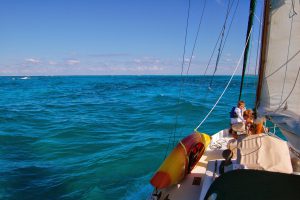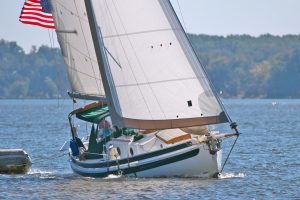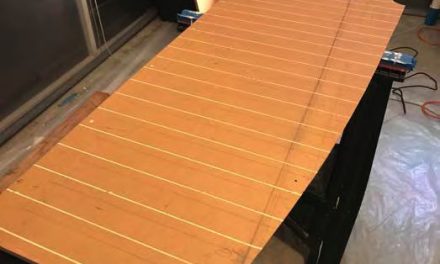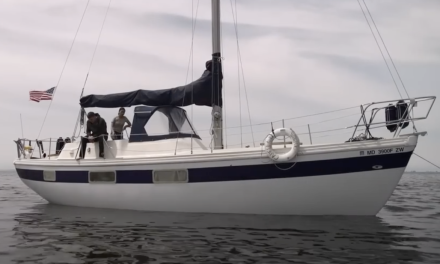If one Bristol Channel Cutter fulfilled their sailing dreams, two could only be better.
“This poor, poor boat,” I thought, looking at the forlorn Bristol Channel Cutter tied to the dock, mold-stiff lines heavy with barnacles where they sagged in the water. Varnish peeled off the bowsprit in sheets. At the waterline, crabs foraged in the forest of swaying, dark-green moss. Wasps flew in and out of the sail cover; the once off-white deck and cabin sides were black with mold.
It didn’t get any better below, my husband, Jeremy, and I gagging on mildew and diesel fumes when we opened the companionway. Water stains spread on the wood under each porthole. A monstrous snake of plastic and wire ran along the cabin sides to a cockpit chart plotter. The keel-stepped mast sat in 5 inches of standing water, oxidized aluminum visible under a water-saturated fiberglass cast.
It was a horror of a project boat. But it was a Sam L. Morse Bristol Channel Cutter.
So, of course we bought it.
And if this sounds a little crazy, consider this: We already own a Bristol Channel Cutter. Calypso has been in our lives for 30 years, having taken us on extended cruises twice already. We’re finishing up a long-term refit that has left no system untouched. We’re well aware of the pitfalls of a project boat; there’s barely enough time to do the work on the boat we already have. Why on earth would we add another?
The simplest explanation is the most honest one. It must be love.
First Love
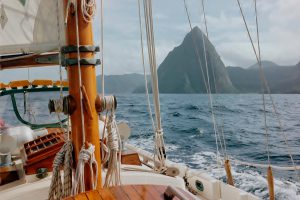 There’s no mistaking a Bristol Channel Cutter. The short rig and long bowsprit, the wineglass transom. The planked bulwarks and outboardrudder. At 28 feet long on deck and 37 feet overall, she looks like she belongs in a different era, one steeped in romance and possibility.
There’s no mistaking a Bristol Channel Cutter. The short rig and long bowsprit, the wineglass transom. The planked bulwarks and outboardrudder. At 28 feet long on deck and 37 feet overall, she looks like she belongs in a different era, one steeped in romance and possibility.
In 1975, Sam L. Morse commissioned Lyle Hess, designer of Lin and Larry Pardey’s Serrafyn and Taleisin, to draw a 28-foot version of those wooden classics to be built in fiberglass. BCCs, as they’re known, are based on old Bristol Channel pilot cutters, work boats that needed to be fast and seakindly. Full keels, a long waterline, and impressive sail area are part of her pedigree. Early hulls were sold unfinished, but eventually the Morse company turned out completed boats. These featured interiors with a pull-out double bunk in the main salon, a workbench in the forepeak, water tanks in the bilge, and storage everywhere.
When we first set our sights on going cruising in 1991, we weren’t looking for a forever boat. All we wanted was one that could take us to the Caribbean for a couple of years on the pulled-from-thin-air budget we’d conjured up.
When we saw the Sam L. Morse Company ad with the line drawing of a small, sturdy, salty-looking sailboat, it instantly made our short list. It ticked all the boxes: less than 30 feet, shallow draft, strong, seakindly, and by all accounts a good sailing boat. The only drawback was finding one we could afford.
Eventually we found hull #006. One of the early, home-finished boats, she was in rough shape. Opened blisters pockmarked the hull. Underneath threadbare blue tarps, raw wood formed the bulwarks. The interior had been essentially gutted of all but the bulkheads and the settees. Still, the light streaming in from the center hatch bounced off the honeyed tongue-and-groove cedar strips. Curved mahogany, varnished to a gleam, edged any opening. It was relatively easy to envision a finished cozy space even if some things needed to be changed right off the bat. (Three-gallon stainless steel lobster pot for a head, chocked into its own perfectly built teak cabinet? See ya!)
We named her Calypso, invoking both Odysseus’ nymph and Trinidad’s music, and, with island music playing on repeat, tackled the first of our refits. Over the next two years, she got a full galley, a new forepeak area that included a double bunk and manual head, and a table big enough to seat six comfortably.
When we left in October 1994 with our beagle, Toby—whom we’d adopted the same day we bought the boat—we’d finished the last, gotta-be-done-before-we-leave projects just the week before, including installing the head through-hull at the dock. And despite more than a few people shaking their heads when we shared our cruising plans, we couldn’t stop grinning as we tucked docklines and fenders into the lazarette. We were off!
We were 25 years old and living large in the boat we’d chosen in part because it was small enough to afford and to maintain. While college friends financed new cars and wondered aloud how we could drop any semblance of employment and sail off—if not into the sunset, at least across it—we were snorkeling, laughing, and marveling at the world that opened to us just by pointing our bow in that direction. Our days centered around basics like weather, food, and friendship, with a good dose of boat projects sprinkled in.
The BCC more than lived up to its reputation as a good sailing boat. Give us a breeze, even a small one, and off we’d go. Once we turned the corner on the trades at Saint Martin and didn’t have to claw to windward for every bit of easting, it really got memorable. The sailing surpassed our wildest dreams, whether we were beam reaching on passage between Caribbean islands at 7 knots or tacking slowly in and out of shallow bays along Venezuela’s coast, making a knot or two and loving it.
True Love
That first cruise, a three-year jaunt from Texas to Venezuela and Bonaire via the Eastern Caribbean and up the U.S. East Coast to Virginia, taught us a lot about hard work and reward. At the center of it all was Calypso, that 28-footer we hadn’t thought was going to be our forever boat.
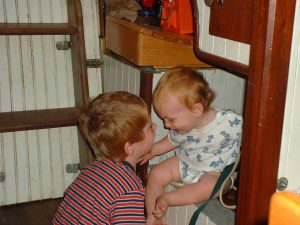
And so, we kept her. The freedom that little boat represented was too precious to sell off, even if we were living a couple of hours inland and only able to spend weekends working on her. Kids came along, and we made the changes to the boat to make it work for them. Lee cloths on the settees formed safe sleeping spaces, the cockpit made a perfect playpen. Legos took over the storage space in the table that once held wine bottles. Our son, Julian, first steered the boat when he was 2; our daughter, Bee, learned to stand up under the chart table.
We talked about taking the kids cruising, but the time never seemed right. And while we thought the boat was too small,
it was never the right time to sell or to buy a different boat, and so we sailed on her and worked on her and lived on her at the dock on weekends.
Then, on our 15th wedding anniversary, what began as the “we’re not going cruising any time soon” lament became an animated discussion about leaving for the Bahamas in 10 months. To hell with the idea that Calypso was too small for a family of four. We had the boat and were all used to spending time on her. Let’s go.
It took surprisingly little to morph Calypso into a proper cruising boat once again. Kids’ books took over the bookshelves, games filled one locker behind the port side settee. We found kid-sized harnesses. Two kayaks joined the 10-foot RIB we’d purchased in a prescient fit of budget-busting in Venezuela, all those years ago. I practiced my nonexistent sewing skills by making cushions for the quarter berth; once the boat’s garage, it would be Julian’s bunk while Bee had the port side settee.
Once again, naysayers rolled their eyes. “You’re going in what size boat?” This time when we left the dock, in September of 2009, it was the kids who laughed with glee as they tucked lines into the lazarette. While their friends back home threw snowballs, Julian and Bee kayaked in the marshes of South Carolina, swam with feeding dolphins in the Abacos, eyeball navigated along the Devil’s Backbone of Eleuthera. Watching them internalize the sense of freedom and empowerment that comes with successful cruising was a highlight of our parenting lives.
One major change we noticed on this cruise was that the average boat size seemed to have grown considerably. Our best buddies sailed a 45-footer; other friends were on bigger boats or catamarans. There just weren’t many small cruisers out there.
 But that cliché that says the sunset looks just as beautiful from the deck of a 28-foot boat is accurate. And sometimes, it felt like we had the advantage. We may have had to leave a couple of hours before our friends to make it to the next anchorage at optimum light, but with a mast 45 feet off the water, raising the main was a two-minute job. Tacking was so easy that we frequently chose to weave our way through the anchorage under sail, extending a gorgeous sailing day with some close-quarter maneuvering. And we still entertained with abandon, including a memorable birthday feast with six adults that culminated with a late-night dishwashing gabfest in the cockpit.
But that cliché that says the sunset looks just as beautiful from the deck of a 28-foot boat is accurate. And sometimes, it felt like we had the advantage. We may have had to leave a couple of hours before our friends to make it to the next anchorage at optimum light, but with a mast 45 feet off the water, raising the main was a two-minute job. Tacking was so easy that we frequently chose to weave our way through the anchorage under sail, extending a gorgeous sailing day with some close-quarter maneuvering. And we still entertained with abandon, including a memorable birthday feast with six adults that culminated with a late-night dishwashing gabfest in the cockpit.
When we returned to land life this time, Jeremy and I had realized that cruising was the goal, and we had no desire to spend the next 25 years of our lives working. But, we also came back to the same question that had pushed back cruising with the kids for so long. Is this boat big enough? Can she accommodate the changes we want?
Spreadsheets gave way to more spreadsheets. We cross-projected until we saw numbers in our sleep. Keep the boat. Sell the boat, buy a different one. Spend money on a refit, spend money on insurance, spend money on maintenance. The answers all kept guiding us to the crux of the matter: Calypso was ours already. We knew what she needed, we knew how to live and sail on her. And, no small consideration, we loved her.
We were four years deep into her complete overhaul, prepping her for long-term life aboard and crossing the Pacific, eyes firmly on that prize. And then…
More Love
 “Hey. Did you hear about the BCC that’s up the Piankatank?” said a fellow owner who cornered us at the yard one day. “Apparently, it’s been kind of rotting at the dock for a while. It can’t be in that bad shape. It’s a BCC! Someone could get a killer deal.”
“Hey. Did you hear about the BCC that’s up the Piankatank?” said a fellow owner who cornered us at the yard one day. “Apparently, it’s been kind of rotting at the dock for a while. It can’t be in that bad shape. It’s a BCC! Someone could get a killer deal.”
Which brought us to the dock where she sat, her lovely lines still apparent beneath the neglect. We’d already decided we were going to buy this boat before we stepped aboard. The lichen-encrusted bulwarks and coamings, the water damage, even the uncertainty of whether the engine would fire—none of these things deterred us. The Sam L. Morse company built 121 BCCs. Losing even one was too sad to contemplate.
And, unlike Calypso, this BCC had been completed at the Morse yard. The touches noted in Ferenc Mate’s World’s Best Sailboats, which highlights the Morse boats—details like brass ventilation plaques at the lockers, the swing-up counter extension linking the stand-up chart table with the sink, the side table where a cabin heater could sit—this boat, unlike Calypso, has them all (along with standing headroom for my 6-foot-2-inch-tall husband).
After looking at old Bristol Channel pilot cutter names, we named her Mischief—a little sneaky, a little joyful, a little sassy. Kind of like these boats themselves.
In many ways, our two boats are flip sides of the same coin. They’re both the same sturdy, classic, overbuilt fiberglass hull and deck. With Calypso, though, we needed to build her, more than once, from the inside out. Along the way, she’s taught us about patience and joy, hard work, and the deep satisfaction in sailing a boat you know intimately. She is memory and stories and laughter in every angle.
Mischief needs some love and care to bring her back to her true self. The thorough cleaning has already begun. Her external woodwork needs sanding and cleaning; the mast likely requires either replacement or massive repair. She needs a bottom job and maybe a blister one. I’m sure that’s just the start of the project list. It’s a boat, after all.
Once again, friends and family are scratching their heads: Just how does another BCC fit into our long-range plans? His-and-hers BCCs? A parts boat for Calypso? A fix-and-flip? None of the above.
Calypso will be the go-far boat, and Mischief will be based on the U.S. East Coast, a boat to restore to glory and explore parts of the Northeast we haven’t seen yet. We get that it may sound crazy. But for us, it’s quite clear.
Love is love. More can only be better.
